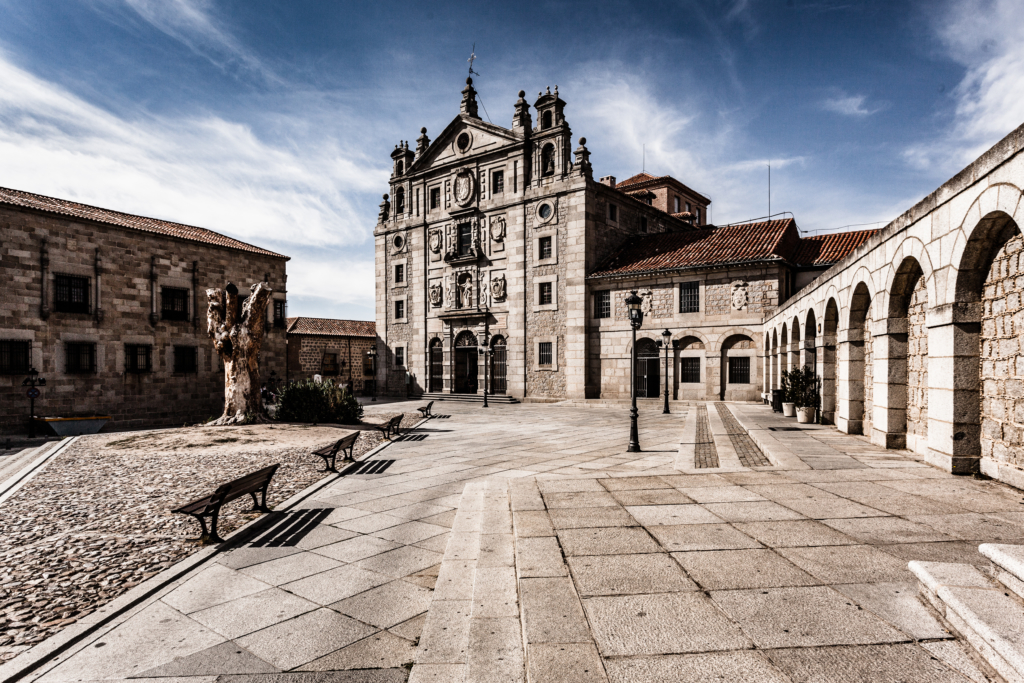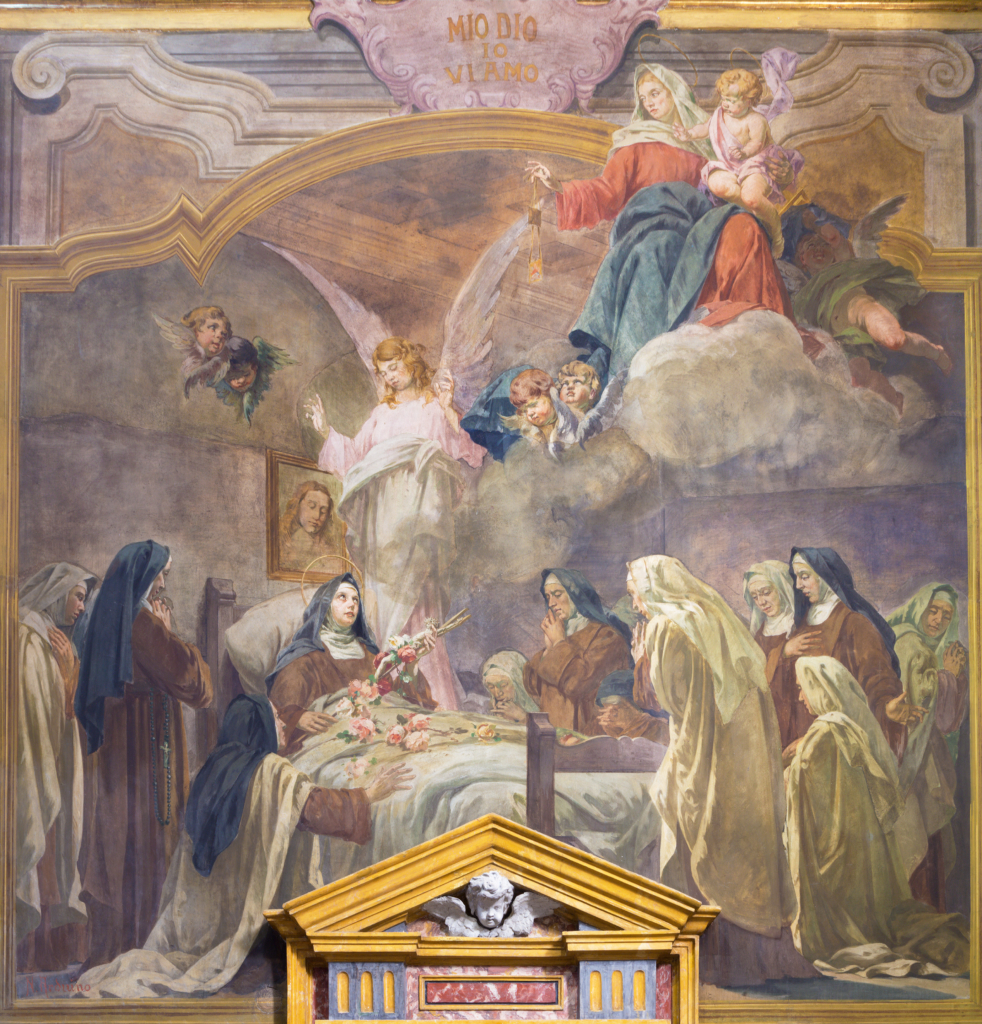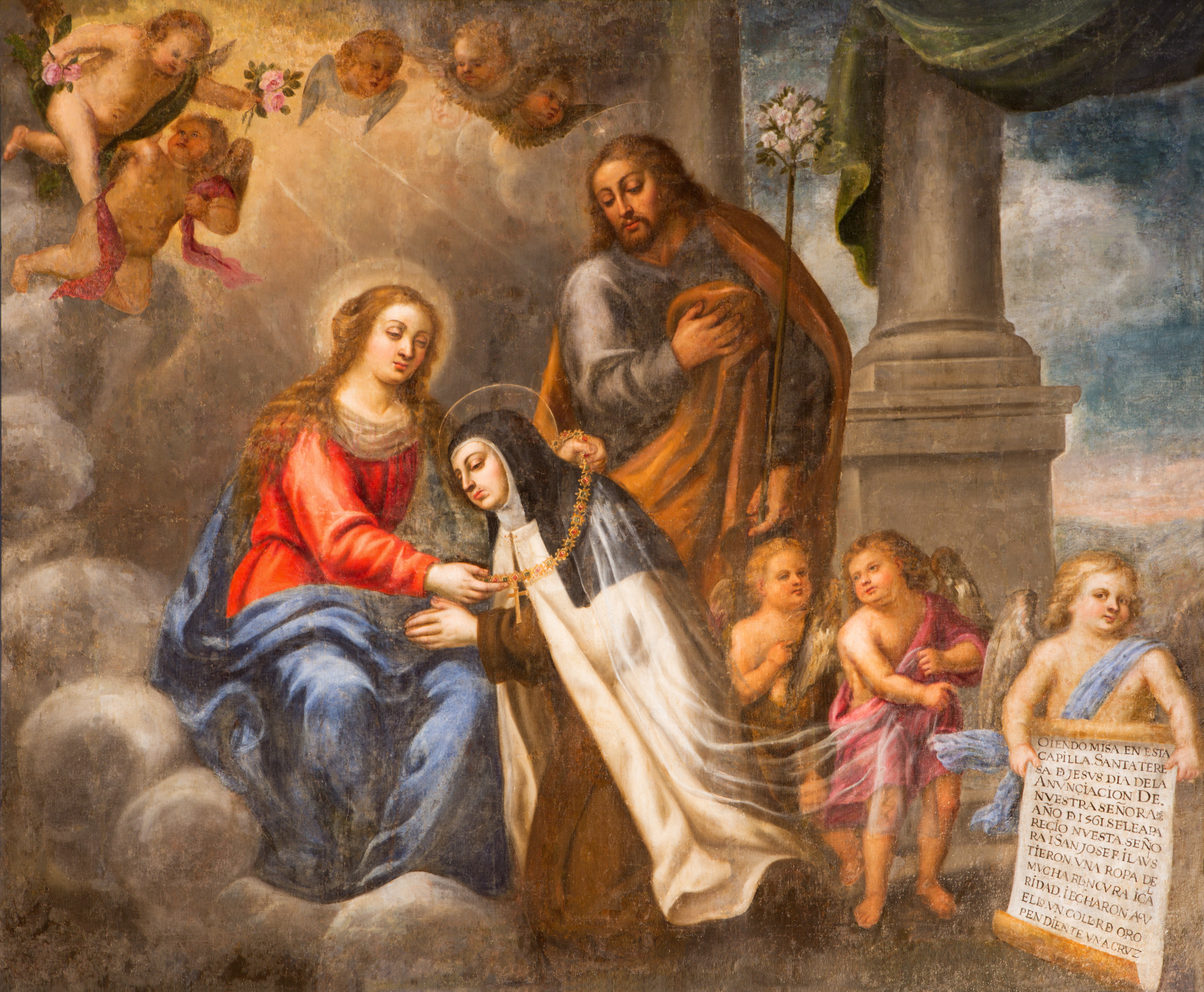Above: AVILA, SPAIN, APRIL – 19, 2016: The St. Theresia of Avila with the Virgin Mary and St. Joseph in church of Real Monasterio de Santo Tomas by unknown artist of 18. cent
1563: St Teresa of Avila (of Jesus)
From the website of the Discalced Carmelites, General Curia of the Teresian Carmel
St Teresa’s whole Marian experience is found scattered throughout her writings, from which we can put together a lovely mosaic of Mary. We will make use of three important traits of Teresian doctrine.
a) Devotion to Mary and Marian mystical experience
From the first page of Teresa’s writings the Virgin Mary appears among the most important memories of her childhood. She recalls the devotion taught her by her mother Beatriz, which found expression in the recitation of the Rosary. The episode of her prayer to Our Lady after the loss of her mother at the age of 13 is very moving: “in my affliction I went to an image of our Lady and begged her with many tears to be a mother to me. It seems to me that though I did this in simplicity, it has been of much help to me; for I know that I have always found favour with this sovereign lady when I have commended myself to her and in the end, she has drawn me to herself”. Teresa then attributes to the Virgin the grace of a constant protection and in a special way the grace of her conversion: “She has drawn me to herself”. Other texts from the autobiography reveal to us the permanence of the devotion to Mary: when she turns to the Virgin in her sufferings, when she remembers her feasts of the Assumption and the Immaculate Conception or the Holy Family or her devotion to the Rosary.
Very quickly the devotion to the Virgin, like other aspects of the Saint’s life, passed into an experience of her mysteries, when God made Teresa enter into contact with the mystery of Christ and all that pertains to it. In Teresa’s mystical experience of the mystery of Our Lady there is, as it were, a progressive penetration into the most important moments of the Virgin’s life, as we find it in the Gospels. Thus, for example, we have an intuition of the mystery of the overshadowing of the Virgin and of her humble and wise attitude at the Annunciation. We know of at least two mystical experiences Teresa enjoyed connected with the first words of Mary’s canticle, the Magnificat which, according to the testimony of Mary of St Joseph, Teresa used to repeat frequently “softly, in Castilian”.
She contemplates with amazement the mystery of the Incarnation: “The Lord wills to enter into the womb of his most holy Mother. Such is the Lord, he brings liberty with him, and thus he loves to make himself like us”. She contemplates the presentation of Jesus in the temple and finds the meaning of Simeon’s words to the Virgin: “Do not think that when you see my Mother holding me in her arms, she enjoyed this happiness without grave torment. From the time that Simeon spoke these words to her, My Father gave her clear light whereby to see what I would have to suffer”. She thinks about the flight into Egypt and the hidden life of the Holy Family.
She had a special intuition of the presence of Mary in the paschal mystery of her Son, on the pain of her desolation and the joy in the Lord’s resurrection. Teresa loved to contemplate Mary’s fortitude and her communion with Christ at the foot of the Cross. In Concepts of the Love of God she describes the Virgin’s attitude: “She was up, and not sleeping, but suffering in her most holy soul, dying a cruel death”. She had entered mystically into the sorrow of the Virgin when the Lord was placed in her arms “as it is portrayed in the fifth sorrow” and had experience at Easter in Salamanca in 1571 of desolation and anguish (a dark night of the spirit) which made her remember the loneliness of the Virgin at the foot of the Cross. On this same occasion the Lord said to her, “On my resurrection I went to our Lady who was in great need…. and I stayed long with her for she was in very great need of consolation”.
On various occasions it was given to her to contemplate the glorification of the Virgin on the feast of her Assumption. She was conscious that the Virgin always accompanied the community at prayer with her constant intercession, as happened at St Joseph’s in Avila and at the Incarnation.
When it was given to her to know the mystery of the Trinity she perceived the closeness of the Virgin to this mystery, and the fact that the Virgin, along with Christ and the Holy Spirit, are the ineffable gifts of the Father: “I have given you my Son and the Holy Spirit and this Virgin. What can you give to me?” It can be stated that the Holy Mother had a profound mystical experience of Mary, that she enjoyed her presence. Teresa also experienced the mysteries of Mary’s life. Consequently in Teresa’s doctrine there runs a deep conviction that the mysteries of the Humanity of Christ and those of his Virgin Mother form part of the mystical experience of those tending to perfection .

Church and convent of St Teresa of Jesus. Avila, Castilla Leon. Spain
b) Mary as model and mother of the spiritual life
Saint Teresa has set down her experience and contemplation of the mystery of the Virgin Mary in a few lines full of doctrine. She would, without doubt, have traced out a beautiful synthesis of Marian spirituality if she had carried out her intention of commenting on the Ave Maria as she did on the Pater Noster in the Way of Perfection.
We can state that among the characteristic virtues of the Virgin which Saint Teresa proposed for imitation there is one that contains all the others. Mary is the first Christian, the disciple of the Lord, the follower of Christ even to the foot of the Cross. Mary is the model of total adherence to the humanity of Christ and of communion with him in his mysteries in such a way that she is the model of a contemplation centred on the sacred Humanity.
Among the virtues which also belong to the Carmelite form of religious life we can cite: Poverty which made Mary poor with Christ; humility which drew God from heaven “into the Virgin’s womb” and so is one of the principal virtues to imitate: “Let us imitate in something the great humility of the most holy Virgin” the attitude of humble contemplation and amazement before the wonders wrought by God and total assent to his will.
Her presence is with us for the whole of our spiritual journey as though every grace and every crucial moment in the maturing of the Christian and religious life needed the active presence of the Mother on the road her children take. Thus the Virgin appears actively present in every description Teresa makes in the Interior Castle of the itinerary of the spiritual life. It is the Virgin who intercedes for sinners when they commend themselves to her. She is the Spouse of the Canticles, the model of perfect souls. She is also Mother in that all her graces are summed up in her union with Christ in “much suffering”. Teresa writes, “We have always seen that those who are nearest to Christ our Lord have the most to suffer: we see what his glorious Mother and the glorious apostles had to go through”. For this reason the memory of Christ and the Virgin in the liturgical celebration of their mysteries accompanies us and gives us strength.

c) The Virgin Mary and Carmel
Teresa of Jesus, in her Carmelite vocation, had entered profoundly into the whole preceding spiritual tradition of Carmel. In the monastery of the Incarnation in Avila she had been able to steep herself in the whole rich Marian spirituality of the Order as it was expressed in the sixteenth century in its historical tradition, spiritual legends, Carmelite liturgy, popular devotion and Carmelite iconography. In her writings the name of the Order is always coupled with that of the Virgin who is the Lady, the Patron, the Mother of the Order and of each one of its members. Everything is Marian in the Order, according to St Teresa: the habit, the Rule, the houses.
When she was appointed Prioress of the Incarnation in 1571 she placed a statue of Mary in the first place in the choir for she knew that the devotion, love and respect of all the religious converged on Mary. This gesture had a delightful epilogue in the apparition of the Virgin. In a letter to Maria de Mendoza (7th March, 1572) she says affectionately, “My ‘Prioress’ (the Virgin Mary) is doing wonders”. She received Fr Gracian with delight as he was devoted to the Virgin, as she frequently recalled in her letters, and she was enthusiastic about knowing the origins of the Order, as narrated in the books written at that time. She was fully conscious of the privileges of the Holy Scapular as appears in this sentence referring to the death of a Carmelite Friar: “I understood that having been a friar who was very faithful to his profession, he had profited by the Bulls of the Order so as not to enter purgatory”.
She undertook the task of the foundation of St Joseph’s in the same Marian spirit as a service of renewal of our Lady’s Order urged on by the Virgin herself. In the first promises made to her by Christ we find an allusion to the presence of the Virgin in Carmel.
Afterwards the Virgin herself urged her to the foundation of St Joseph’s with identical words and promises and with a special grace of interior purity conceded to Teresa for her task of foundress. At the happy conclusion of the foundation of St Joseph’s, Teresa set down her Marian sentiments in these words, “As for me, it was like being in glory to see the Blessed Sacrament reserved…. and to have completed a work which I understood was for the service of the Lord and in honour of the habit of his glorious Mother”. “We keep the Rule of Our Lady of Carmel … please God all will be for his glory and praise and that of the glorious Virgin Mary, whose habit we wear”. In response to this Marian service she saw Christ who thanked her for “what she had done for his Mother”, and she saw the Virgin “in great glory, wearing a white mantle with which she seemed to enfold us all”.
In narrating the progress of the Reform, Teresa always took care to stress its continuity with the Order, the service done for Our Lady, and the special protection afforded by Mary on all occasions. Thus, for example, the encounter with Fr Rubeo and the permission obtained to increase the Teresian monasteries: “I wrote a letter to our Father General … placing before him the service it would be to Our Lady, for he has great devotion to Her. She must have been the one who managed it”. The whole book of the Foundations appears to have been written in a Marian key with continual allusions to the Virgin and her service: “These little dovecots of Our Lady began to be filled up”. “This was the beginning of the renewal of the Rule of the Virgin Mother and Lady, our Patron” she says of the foundation of Duruelo. When she looked back, at the end of the book of Foundations, she saw it all as a service done for the Virgin, who herself had collaborated in the work: “We rejoice to have been able to render some service to our Lady Mother and Patron… little by little things have been done for the honour and glory of this glorious Virgin and her Son”. Even the separation of the Calced from the Discalced made by the Chapter of Alcala in 1581 is seen by Teresa as part of the peacemaking work of the Mother of the Order: “Our Lord has done an important work … for the honour and glory of his glorious Mother, for she is of the Order as Our Lady and Patron”.
On various occasions the thought of the Virgin arouses in Teresa an understanding of the Carmelite vocation inspired by Mary. Here, for example, with an implicit reference to Mary she writes, “All of us who wear this holy habit of Carmel are called to prayer and contemplation. This call explains our origin; we are descendants of men who felt this call, of these holy fathers of Mount Carmel who in such great solitude and contempt for the world sought this treasure, this precious pearl we are talking about”.

TURIN, ITALY – MARCH 13, 2017: The fresco The Death of St. Theresia in church Chiesa di Santa Teresa by Rodolfo Morgari (1827 – 1909).
In the surrounding context the Saint speaks of the vocation to prayer as a hidden treasure, a precious pearl both Gospel allusions which are within us and demand the total gift of our life in order to buy the field where the treasure is buried and acquire the pearl of great price. Mary appears as the Mother of this “race of contemplatives”, through her interior life of meditation and her total gift of self to the Lord. On another occasion Teresa calls attention to the imitation of the Virgin so that we may be called in truth her children: “Please God, sisters, we may live as true daughters of the Virgin, faithful to our profession, so that the Lord may grant us the mercy he has promised”. Teresa’s idea of fraternity, with its reciprocal love and sharing of goods, has for its foundation love of the Virgin and the sense of belonging to the same family, as these two texts suggest: “And so my daughters, all belong to the Virgin and are sisters and should seek to love one another greatly”. “As we all wear the same habit, the monasteries should help one another, for what touches one, touches all”.
These pages show how the Holy Mother had lived integrally the Marian tradition of the Order, enriching it with her mystical experience, her devotion and the doctrinal orientation of her writings. In Teresa’s view the Virgin is the model of adherence to Christ and of the contemplative living of his mystery and ecclesial service for the Discalced Carmelite. The Virgin is the Mother in each monastery, increasing by her presence the sense of intimacy and family, an aid on the road of the spiritual life, presiding over the prayer life by her fervent intercession with her Son.
To be continued….
Resources:
- Website of the Discalced Carmelites, General Curia of the Teresian Carmel, LINK to original article that contains all the referred to sources in the above reprinted article.









Leave A Comment
You must be logged in to post a comment.